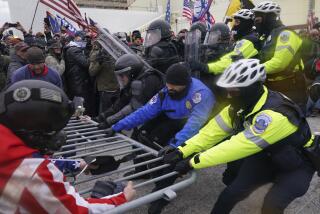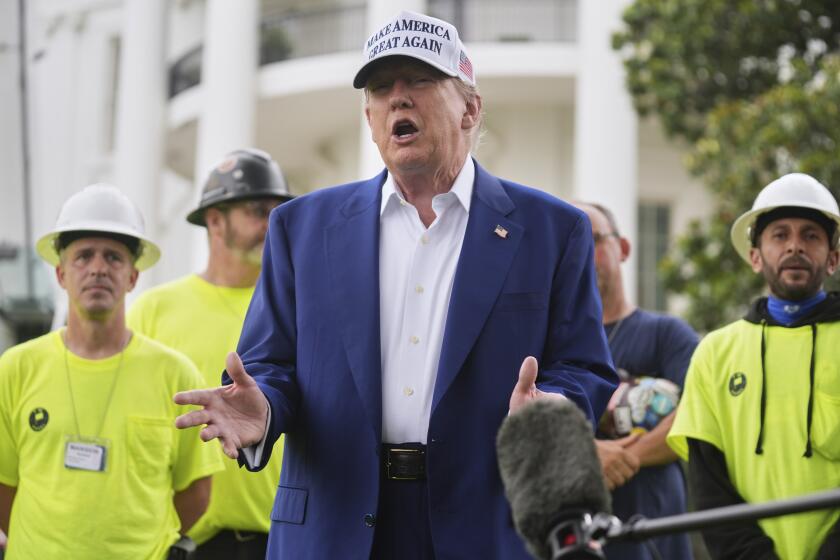A worm’s-eye view of history
- Share via
WASHINGTON — You wouldn’t think a presidential inauguration would require a survivors group. But shortly after thousands of ticket holders were trapped in an underground tunnel beneath the National Mall on Tuesday, a new Facebook group was born: Survivors of the Purple Tunnel of Doom. Membership as of Thursday evening: 3,950.
Sen. Dianne Feinstein (D-Calif.), head of the Joint Congressional Committee on Inaugural Ceremonies, which was responsible for the event, has apologized to the distressed visitors -- whose color-coded tickets were purple -- and called for an investigation by the law enforcement agencies that planned the event, which include the U.S. Secret Service and the U.S. Capitol Police.
“Sen. Feinstein was very displeased,” committee spokeswoman Carole Florman said. “Word has gone out to get some answers.”
Among the nearly 2 million people who streamed onto the National Mall on Tuesday were thousands of purple-ticket holders. Some were campaign volunteers, some were well-connected donors, others had simply requested tickets from elected officials.
Many arrived five or six hours before the noon swearing-in and were told that gates would open at 8 a.m. They formed themselves into a line that stretched south, more than a mile by many accounts, into the city’s 3rd Street tunnel, which is part of Interstate 395 and runs under the Mall.
Then they waited. And waited. Nine o’clock came and went. The line stayed put. Parents grew uncomfortable holding small children because strollers weren’t allowed on the Mall. Men relieved themselves against the tunnel walls because there were no portable toilets. To the tune of “We Shall Overcome,” they sang “We shall get inside.”
Eventually it became clear to people that not only was the line not moving, but that they had no way to get to any part of the Mall in time to take in the inaugural moment. Some later said that the entrance gate to the purple area was closed, seemingly abandoned by security personnel.
“There was no one to aid or guide us,” said Pat Silberfeld, a Democratic activist from Beverly Hills. “I guess security totally broke down.” Silberfeld, who did not arrive at the tunnel until about 8 a.m. because she had food poisoning, saw a man writing “Free the tunnel people” in the grime of the tunnel wall.
“I don’t believe anybody who was not there fully understands the real potential there was in the line at the purple gate and in the Purple Tunnel of Doom for disaster,” said Lulu Chiu, a 23-year-old federal government employee. “It was only through the grace and civility of the people who are only now speaking out about it after the fact that there was not a fatal stampede or disruptive mob. It was only because we were all just happy that [Barack] Obama was going to be our president that kept our spirits up.”
Clare Fader, 34, who’d taken the train from Baltimore that morning at 3 a.m. with her husband and two teenage cousins, had scouted the area the day before to make sure she knew where to go.
“We were doing as we were told,” Fader said. “At first the police seemed like they had things organized; they checked our tickets and told us to go into the tunnel. We were there for four hours. And they were the only authorities we saw. The most incredible part is that it could have been so dangerous if people had not behaved so beautifully.”
When she and her family finally left in frustration, they passed a police station and joked that perhaps if they were arrested, they could watch the inauguration on TV inside. Eventually, they ended up with about 20 strangers crowding around a parked car whose driver had turned up his radio so people could hear.
Late Thursday, Senate Sergeant-at-Arms Terry Gainer, the Senate’s chief law enforcement officer, attended a meeting with the head of the Secret Service and the Capitol police. He also had spoken by phone with the District of Columbia’s police chief. They reviewed video of the purple gate taken by a fixed security camera as well as satellite and still photos, trying to figure out what had gone wrong. He disputed much of what eyewitnesses described but admitted the situation was “clumsy.”
Gainer said the purple gate opened at 7:33 a.m. and did not close until moments before noon, when the metal detectors had to be removed to accommodate exiting crowds. He also said that people may not have realized how many law enforcement officers were in the crowd because many were not in uniform.
It appears, he said, that the tunnel backup occurred because some people with silver-colored tickets were misdirected to the parade route and had to be redirected to the Mall. Also, President Bush’s motorcade blocked movement for a time.
“It was painful to people who had a bad experience,” Gainer said. “But I think it went very well for about 240,000 people with tickets and about 1.7 million people on the Mall. Obviously, it did not go well for between 1,000 and 4,000, and I feel bad about that, but on balance, one couldn’t conclude anything but that this was a pretty well-run operation. . . . We did a good job on about 98% of this.”
Elected officials who were responsible for disbursing tickets heard from unhappy constituents and began pressing for answers.
In a letter to Feinstein, Maryland Democrat Rep. Chris Van Hollen wrote that he was “baffled by the breakdown, on such a broad scale, of the processing of people who followed the rules and came only to see, hear and be part of this remarkable moment in our nation’s history.”
Florman, the inauguration committee spokeswoman, said attempts would be made to compensate people for the foul-up. “This won’t make it up to people,” she said, “but we are working on a plan to provide people who had this terrible day some commemorative materials.”
She said that would probably include invitations, programs and a color photo of Obama taking the oath of office. How the committee expects people to prove they were shut out is unclear. “We have to come up with something that is workable,” Florman said, “but doesn’t allow just anybody to say, ‘Hey, I was one of them.’ ”
Natalie Baack, 27, works for an entertainment market research company. The Palms resident was with a friend and her friend’s 60-year-old mother. When they finally made their way out of the tunnel, and even hopped a fence, they ended up in front of the Canadian Embassy. She was so distraught, she was weeping as she craned her neck to see a television at the embassy.
“I was just crying and crying at this point,” Baack said. “A woman took my picture, and I asked her to delete it. She said, ‘I want to capture the moment.’ Then I told her why I was crying, and she felt awful.”
Times staff writer Richard Simon contributed to this report.
More to Read
Get the L.A. Times Politics newsletter
Deeply reported insights into legislation, politics and policy from Sacramento, Washington and beyond. In your inbox twice per week.
You may occasionally receive promotional content from the Los Angeles Times.











